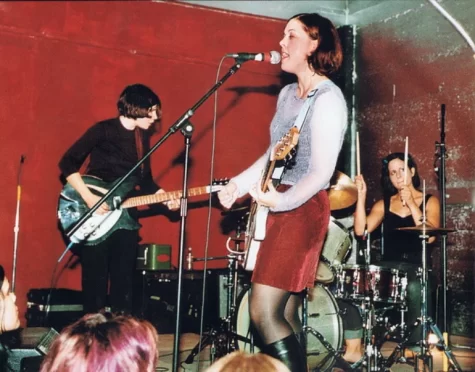EXPLORING RIOT GRRRLS
February 2, 2023

The women of Olympia, Washington, started a revolution in the 1990s. Its primary focus was to deconstruct the social systems which reinforced gender roles and enabled toxic masculinity. As a result, it aimed to accommodate the needs of women and girls. It encouraged them to insert themselves into spaces that may have instinctually rejected them and deny their own internalized sexism. This movement was developed in the spirit of third-wave feminism and was known as the Riot Grrrl movement.
“Riot Grrrl” was a term coined by the punk band Bratmobile. The three members created the all-girl band in Olympia, Washington, and were actively performing from 1991 to 2003. Their lead singer, Allison Wolfe, is recognized as the core founder of Riot Grrrl. She created the term to normalize and encourage girls to “riot” by making noise and taking up space. Even the word grrrl (girl) is intended to simulate a growl. Intentionally distorted by Wolfe as a way to capture the passion, aggression, and strength of the community.
Riot Grrrls’ heavy punk influence made it inherently political in its early and original days, and its focus rested on socio-political and socio-economic ideas. Subjects in this music genre are commonly centered around women’s struggles and discrimination. But the critiques of oppressive systems spread to entities like capitalism as well.
The unapologetic nature of the movement and its ability to empower had gathered and urged members of this subculture to commonly participate in “various DIY self-expression outlets, including radio shows, public access television programs, spoken word performances, art, and film to communicate their ideals. The female body even became a tool in DIY culture.” (commons.lib.jmu.edu) Fanzines were another iconic method of communication that this subculture popularized in the ’90s. Popular fanzines overcoming subjects such as rape, abuse, exploitation, and issues with capitalism were “Bikini Kill, Fantastic Magazine, Girl Germs, and Riot Grrrl” (shsu.edu). Maximizing the space for female voices in an intentional way “provided an avenue for women to reclaim their agency” (commons.lib.jmu.edu) and remove the impression that feminism and other kinds of activism were inherently strenuous.
Riot Grrrl’s music harnesses a sound akin to rock, surf rock, and punk. Similar to Grunge it pulled heavy influence from punk while still managing to create its distinctive sound. A common distinctive feature of Riot Grrrl bands was the tone of voice and recurring “valley girl” accents and characters that would be performed in tandem with the punk rock messaging as a means of irony. This wasn’t required but has become one of the most defining features of Riot Grrrl. Many members of these bands were musical autodidacts or had limited experience. They sought to reflect the power of an individual girl and demonstrate that success. Along the way, popular performers of Riot Grrrl bands “-including Bikini Kill, Babes in Toyland, Fifth Column, Huggy Bear, Lunachicks, Sister George, Slant 6, Sleater-Kinney, and Tribe 8” (shsu.edu) inspired many to deny the insecurity of not being strongly established musically.

black • Sep 4, 2023 at 1:42 pm
sista grrrl…….